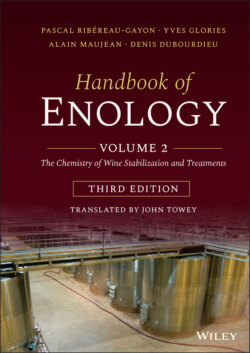Читать книгу Handbook of Enology, Volume 2 - Pascal Ribéreau-Gayon - Страница 24
1.4.2 Expression of pH in Wine
ОглавлениеWines are mixtures of weak acids, combined to form salts to a greater or lesser extent according to their pKa (Table 1.3). The proportion of salts also depends on geographical origin, grape variety, the way the vines are trained, and the pressing and winemaking methods used.
Due to their composition, musts and wines are acid–base “buffer” solutions, i.e. a modification in their chemical composition produces only a limited variation in pH. This explains the relatively small variations in the pH of must during alcoholic and malolactic fermentations.
The pH of a solution containing a weak monoprotic acid and its strong basic salt proves the Henderson–Hasselbalch equation:
(1.2)
This equation is applicable to must and wine, where the most important acids are diacids. It is an approximation, assuming the additivity of the acidity contributed by each acid to the total. The application of Equation (1.2) also makes the simplifying assumption that the degree to which the acids are combined in salts is independent of each other. These assumptions are currently being challenged. Indeed, recent research has shown that organic acids react among themselves, as well as with amino acids (Dartiguenave et al., 2000a).
FIGURE 1.3 Comparison of the titration curves of a must and the corresponding wine.
Comparison (Table 1.3) of the pKa values of tartaric (3.01), malic (3.46), lactic (3.81), and succinic (4.18) acids leads to the conclusion that tartaric acid is the “strongest,” so it will take priority in forming salts, displacing, at least partially, the weaker acids. In reality, all of the acids interact. Experimental proof of this is given by the neutralization curve of a must, or the corresponding wine, obtained using sodium or potassium hydroxide (Figure 1.3). These curves have no inflection points at pH corresponding to the pKa values of the various acids, as there is at least partial overlapping of the maximum “buffer” zones (pKa ± 1). Thus, the neutralization curves are quasi‐linear for pH values ranging from 10 to 90% neutralized acidity. They therefore indicate a constant buffer capacity in this zone. From a more quantitative standpoint, a comparison of the neutralization curves of must and the corresponding wine shows that the total acidity values, assessed by the volume of sodium hydroxide added to obtain pH 7, differ by 0.55 mEq. In the example described above, both must and wine samples were 50 ml, and the total acidity of the wine was 11 mEq/l (0.54 g/l as H2SO4) lower than that of the must. This drop in total acidity in wine may be attributed to a slight consumption of malic acid by the yeast during alcoholic fermentation, as well as a partial precipitation of potassium bitartrate (insoluble in alcohol).
The slope of the linear segment of the two neutralization curves differs noticeably. The curve corresponding to the must has a gentler slope, showing that it has a greater buffer capacity than the wine.
The next paragraph gives an in‐depth description of this important physicochemical parameter of wine.
